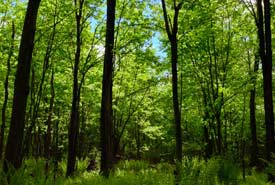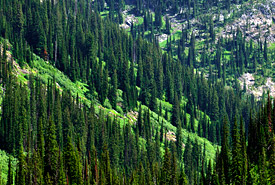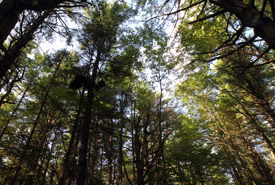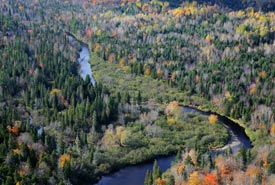Why Canada needs more forest conservation

Forest in Saint-Georges-de-Clarenceville (Photo by NCC)
Canada is a nation defined by many things: multiculturalism, hockey, universal health care, politeness, eh? We’re also a nation defined by our landscapes. Prime Minister William Lyon Mackenzie King once referred to Canada as a country with “too much geography.” Yet it is that vast geography that defines Canada and Canadians, and no other habitat within that geography defines our country more than forests.
Canada is a forest nation. Yes, we have spectacular mountains, prairie grasslands, arctic barrens and oceans; but the one habitat that runs throughout every province and territory, and where most Canadians live, is forest. How much forest is in Canada? Officially, it’s about one-third (or roughly 3.5 million square kilometres) of the country. If we include smaller trees found along the wide edge along the northern border of the boreal forest (referred to as Taiga), about half of Canada is forest. It’s a lot of Canada, and also a lot of the world’s forests. Canadians steward about nine percent of the all the world’s forests, but a whopping 25 percent of the planet’s most intact and pristine forests.

Valley view, Darkwoods, British Columbia (Photo by Tim Ennis/NCC)
These forests are important for our well-being and economy. Forests supply important ecological services: they provide habitat for many species, help purify our air and water and hold vast amounts of carbon. Many large Canadian cities such as Vancouver and Halifax have their drinking water safeguarded by protected forested watersheds.
Forestry employs more than 200,000 Canadians and is the key industry in many northern communities. Our forested parks and protected areas are also one of the primary destinations for international tourists, attracting more people than museums, art galleries, cultural events or festivals.
Despite everything forests provide to Canada, our collective stewardship of this quintessential Canadian landscape may be falling behind. The 2010 report on ecosystem status and trends in Canada concluded that the quality and intactness of our forests is declining, along with the area of old growth. The newly released Global Forest Resource Assessment 2015 by the United Nations highlights how Canada compares the rest of the world when it comes to forests on two important measures: forest loss and forest protection.

Whitemouth River Watershed Natural Area, MB (Photo by Mike Dembeck)
Canada is one of only a few developed countries continuing to lose forest. Although the amount of forest lost to other land uses in Canada between 1990-2015 is relatively small (>123,550 acres/50,000 hectares annually), many other nations, including the U.S., China, Australia and most of Europe, have reversed past declines and are now gaining forest cover.
The report also compares the amount of forest in protected areas. Approximately seven percent of Canada’s forests are in parks and protected areas. This is a significant amount of forest in a country as large as Canada, but we are behind other nations in the percentage of protected forest including the U.S. (11 percent), China (13 percent), Australia (17 percent) and Brazil (42 percent). Globally about 17 percent of all forests are in protected areas.
Why has Canada protected less forest than these other countries? It could be a combination of many factors: some of our most northern and remote forests are not under immediate threat, there are competing land uses, many of our working forests are well-managed, we may still think there is an endless abundance of forest in our vast geography.

Bartholomew River, Miramichi, NB (Photo by Mike Dembeck)
Canada has an admirable record in parks and protected areas. Some of the first national parks in the world were created in here and approximately 12 percent of the Canadian landscape is in parks and other protected areas. Canada has also committed to increasing this amount to 17 percent by 2020 to meet international targets. We need to focus on forests as we identify and protect these new areas.
While protected areas are only part of effective nature conservation, they play an important role. Protected areas such as national or provincial parks, or the more than 600,000 acres (250,000 hectares) of forests protected by the Nature Conservancy of Canada, conserve important habitats and species, allow forests to develop into old growth and can serve as benchmarks to measure the sustainable use of our working forests. Just as importantly, they have provided a gateway for generations of Canadians to explore and experience our forests.
As custodians of some of the last great forests left on the planet, we have a responsibility to the world to protected steward forests. We have a responsibility to Canadians to keep our forest nation.


